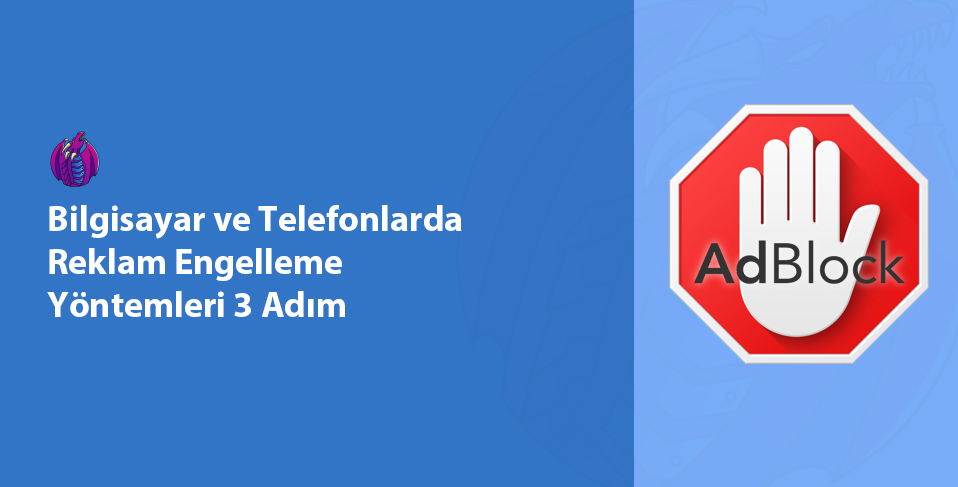Free 1-Year Domain Offer with WordPress GO Service

Advertising content can sometimes negatively impact user experience. Especially ad blocking on phones or ad blocking on computer With solutions like these, web and application usage can become more enjoyable. In this article, ad blocking We will examine the details of the methods, their advantages and disadvantages, alternative solutions for different devices and platforms; we will also answer frequently asked questions.
1. Importance and Overview of Ad Blocking
One of the main sources of income on the internet is advertising. Advertising helps publishers earn money by allowing websites to offer free content. On the other hand, for some users, advertising can become annoying: excessively loud video ads, full-screen pop-ups, non-stop ads in games, etc. ad blocking comes into play.
- Saving time: Page loads can be much faster without ads.
- Data saving: If your mobile data usage is limited, blocking image or video ads can save you money.
- Focusing: Especially on devices used for education and work, blocking ads can help prevent distractions.
1.1 Advantages
- Faster scanning: Blocking ads increases the speed at which pages load, especially when there are no display or video ads.
- Increased security: Some harmful ads (including malware) can be blocked to keep your system safe.
- Reduction in data consumption: Video and animated ads consume high data consumption; blocking them will save data.
1.2 Disadvantages
- Material damage to content producers: Websites that offer free content need advertising revenue, and blocking ads can reduce that revenue.
- Customized experience loss: Advertisements may sometimes offer product or service recommendations that may be of interest to you.
- May impair the functionality of the site: Some sites have restrictions against ad blockers, so you may not be able to fully enjoy the site while the blocker is active.
2. Ad Blocking Methods on Computer
Ad blocking on computer When it comes to this, the first things that come to mind are browser add-ons and DNS-based solutions. There are dozens of different methods for desktops and laptops. Let's examine the most popular methods here.
2.1 Browser Add-ons
The most common and easiest way is to use your browser AdBlock, AdBlockPlus, uBlock Origin, AdGuard is to install free and popular extensions such as. These add-ons detect advertising sources on the page and block them.
- Ease of Installation: It can be activated in a few clicks in popular browsers such as Chrome, Firefox, Edge or Opera.
- Customization: You can customize your ad blocking rules and allow ads on certain sites.
- Filter Lists: Thanks to the filter lists constantly updated by the communities, you are also protected from new advertising sources.
For example, in the desktop Chrome browser, from the “Extensions” menu uBlock Origin or AdBlock Searching for and adding the extension is an extremely practical solution.
2.2 DNS Based Ad Blocking
Some users prefer services that offer solutions via DNS (Domain Name System) instead of a browser add-on. This method uses special DNS servers that automatically filter out advertising domains.
- Example DNS Services: AdGuard DNS, NextDNS etc.
- Device Independence: Once DNS settings are applied to the router, all computers using the same network can benefit from ad blocking.
- System Resource Saving: There is no need for a constantly running extension like browser add-ons.

3. Ad Blocking Solutions on Phones
Smartphones are one of the devices where users see ads most often. In-app ads, browser ads, and in-game pop-ups can be a very annoying experience. Fortunately, ad blocking on phones There are various options available for use.
3.1 Ad Blocking on Android Devices
Android users can block ads in two primary ways: browser-based solutions and system-wide blockers.
- Browser Add-ons or Special Browsers: You can use AdBlock Plus, AdGuard or similar extensions on browsers like Chrome and Firefox, or even Brave And Kiwi You can switch to browsers that come with ad blocking features, such as .
- DNS Method: You can use a DNS provider like “dns.adguard.com” by following Settings > Connection & Sharing > Custom DNS.
- In-App VPN Based Solutions: Frequently used applications such as AdLock or AdGuard work with a built-in VPN and block advertising connections.
3.2 Ad Blocking on iPhone (iOS) Devices
Safari Browser on iOS platform supports ad blocking feature by default but for this ad blocking you need to use applications.
- Ad Blockers for Safari: In the app store AdBlock, AdGuard or 1Blocker You can find options such as.
- Custom DNS Settings: On iOS 14 and above, you can apply the DNS profile manually or use VPN-based blocking apps.
- Advantage: Because app permissions on iPhones are strictly controlled, blockers generally work stably.

4. Alternative Solutions and Other Methods
Some types of ads can be embedded directly into web pages or application interfaces. This is where traditional blockers may be inadequate. Here are a few additional methods to consider:
4.1 Private VPN Services
Private VPNs that include ad blocking provide granular protection by filtering all traffic, so all your connections are scanned for ads whether you’re browsing on a computer or phone.
4.2 Special Operating Systems and Settings
Linux or custom Android ROMs may offer some ad-blocking features built in, but this method can be challenging for beginners as it requires technical knowledge.
4.3 Text-Based Browsers
Although it’s a very old approach, browsing with text-only browsers (e.g. “Lynx”) automatically disables all visual and video ads. Of course, this method completely destroys the visual experience.
5. Sample Scenarios and Applications
Ad blocking methods can often produce different results depending on the device or network you are on. Let's clarify with some concrete examples:
- Connecting to a Shared Network in the Office: If it is not possible to implement a specific DNS setting in your workplace, browser extensions are an instant solution. You can add AdBlock or AdGuard extensions to your own user and get a pure internet experience.
- Ad-Free Experience for All Devices at Home: By entering ad-blocking DNS into your router's DNS settings, you provide a common blocking scheme for all computers and phones in the house.
- Rooted Android Devices: Some advanced users use special software that blocks ads on the entire phone, thanks to root access. In this case, all in-app ads are largely blocked.
6. External and Internal Links
For more technical details and official sources AdBlock Official Site You can get information via.
Also, if you want to learn different optimization tips, you can visit our site. SEO Recommendations Be sure to check out the section. There are many tips you can use along with ad blocking, especially regarding speed and security.
7. Frequently Asked Questions (FAQ)
Question 1: “Is ad blocking legal or dangerous to use?”
Ad blocking software is not considered as any illegal activity worldwide. However, the terms of use may vary in different countries and platforms. Websites may sometimes detect such blockers and restrict the user in order to protect the financial gain of content creators. Whether or not to use it is entirely up to you.
Question 2: “What is the simplest method for ad blocking on phones?”
Using a private DNS is usually the simplest solution. On Android devices, if you enter a value like “dns.adguard.com” in Settings > Connection & Sharing > Private DNS, most ads will be blocked automatically. Similar DNS profiles or Safari extensions can be preferred for iPhone.
Question 3: “When I block ads on my computer, sites give an error, what should I do?”
Some sites have a special detection system against ad blockers. In this case, you can view the site normally by adding it to the 'allowed sites' (whitelist) list in the plugin you use. This will ensure that the site content works properly.
8. Conclusion and General Evaluation
Ad blocking methods, both ad blocking on phones as well as ad blocking on computer offers a range of different options for security. Users can consider a range of options, from DNS-based solutions to browser add-ons, VPN-based methods to dedicated applications. Each method has its own advantages and disadvantages. For example, a plugin may provide quick installation but may not provide full system protection, while a DNS-based solution may cover all devices but may require technical installation.
The ideal approach is to use one or more methods together, taking into account your personal needs and internet usage habits. It is also important to remember that completely blocking ads can harm content providers’ revenue models. As a result, the option of maintaining a balance and re-enabling ads on sites where necessary should not be overlooked.
We hope this guide has answered your questions about ad blocking. You can make the right decision by looking at the recommended resources during the installation and setup phase, and make your internet experience faster, safer and more enjoyable.


Leave a Reply